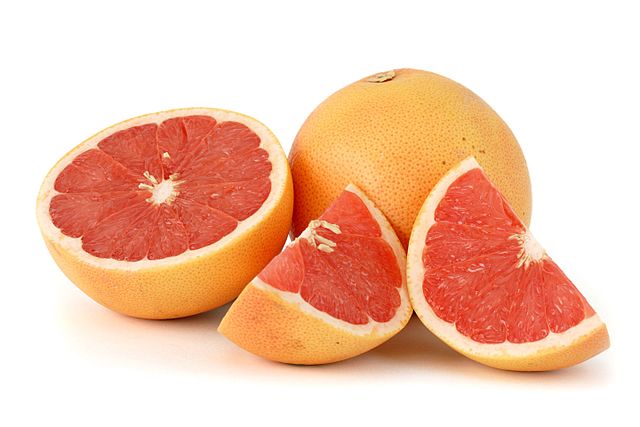Grapefruits: The Nuclear Fruit?

The Hulk is a Marvel superhero who you’re almost certainly familiar with — he’s big, he’s green, and he’s always angry. He’s a human — Dr. Bruce Banner — who was somehow exposed to a large amount of gamma radiation, and instead of killing him, created an alter ego that sometimes takes over Dr. Banner’s body and consciousness and then goes and smashes things, often without discretion. While hardly the point of the character, the Hulk provides a good lesson to kids: don’t play with gamma radiation.
Unless you want to create a very popular cultivar of grapefruit, that is.
Pictured above is a red grapefruit and, specifically, a variety called the “Rio Star” grapefruit. As the Dallas Morning News reported in 2014, the Rio Star is the most commonly (if not exclusively) grown grapefruit in Texas, which is saying something; Texas grows the second-most grapefruits in the United States (after Florida) and since 1993, the red grapefruit has been the state’s official fruit. Red grapefruits are supposedly sweeter than other grapefruits (although one of Bon Appetit’s writers disagrees), and they’re definitely more popular than their white-colored compatriots, often outselling their more mundane-looking cousins 2-to-1.
Like many popular fruits today, red grapefruits are a natural mutation that someone discovered and then cultivated. The original red grapefruits date back to the mid-to-late 1920s and aren’t all that interesting for our purposes. But thirty or so years later, people were still fascinated by the red flesh of the yellow-skinned fruit. And many other people were also fascinated by atomic radiation. The world had just seen the devastating destructive power of the atomic bomb but did not yet fully understand the dangers of atomic radiation; instead, many were looking for ways to take that radiation and turn it into a useful tool. In 1953, President Dwight D. Eisenhower gave a speech to the United Nations titled “Atoms for Peace,” which paved the way for everyday citizens to use nuclear materials in their research and experiments. That included the experiments of Dr. Bruce Banner, sure, but also for people who wanted to grow their own fruits and vegetables in their backyard.
In 1959, a British scientist and nuclear enthusiast named Muriel Howorth started the “Atomic Gardening Club.” Laboratories from around the world — the U.S., Europe, India, Japan, and the Soviet Union all had participating labs — exposed seeds from various crops to gamma radiation. Those radiated seeds were distributed by the Club to volunteer growers — farms, yes, but also everyday people — around the world. The idea was simple: using what would now be called “crowdsourcing” (but is basically just large-scale trial and error) the Atomic Gardening Club hoped to find new cultivars that produced more resilient crops, better tasting foods, or gave people superpowers. (Maybe.) And the Club had some notable and important successes: for example, according to the New York Times, “in 1960, disease heavily damaged the bean crop in Michigan — except for a promising new variety that had been made by radiation breeding. It and its offspring quickly replaced the old bean.”
But the red grapefruit industry is the big beneficiary of gamma growing. Around the atomic gardening became popular, grapefruit growers developed a weird problem; the red cultivars from the 1920s were losing their color, becoming more pink than red — and also becoming less sweet (and less popular). So, some grapefruit growers experimented with gamma rays. And it worked. In 1971, gamma rays helped growers produce the “Star Ruby” cultivar, which at the time was the reddest of the bunch. Fourteen years later, the industry developed the “Rio Red” grapefruit, which was even redder. In the last 20 years, growers have combined the “Star Ruby” and “Rio Red” into the “Rio Star” variety that dominates Texas orchards today.
So if you like red grapefruits, you can thank gamma radiation for them. And don’t worry about the dangers associated with atomic energy or nuclear bombs — red grapefruits aren’t going to cause you to Hulk out or anything like that. If anything, the nuclear-induced redness may be good for you; the red hue means that the fruit is high in lycopene, an antioxidant.
Bonus fact: The Hulk isn’t supposed to be green. But as Screen Rant explains, things don’t always to go plan: “the alter ego of Dr. Bruce Banner was originally intended to be grey but due to issues with inking comic pages in the early ’60s, his color was changed by creators Stan Lee and Jack Kirby to be green.”
From the Archives: Radioactive Red: Plates, not fruit. But still kitchen-related! and still red! And radioactive!
